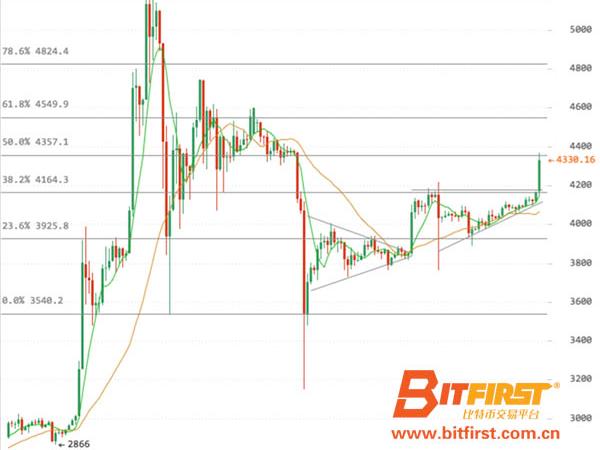主页 > imtoken币不见了 > 以太坊源码--POW挖矿源码分析
以太坊源码--POW挖矿源码分析
PoW 挖矿
代码建立在学习以太坊挖矿之前了解几个相关数据结构的基础上:
数据结构1:
type Miner struct {
mux *event.TypeMux // 事件锁,已被feed.mu.lock替代
worker *worker // 干活的人
coinbase common.Address // 结点地址
mining int32 // 代表挖矿进行中的状态
eth Backend // Backend对象,Backend是一个自定义接口封装了所有挖矿所需方法。
engine consensus.Engine // 共识引擎
canStart int32 // 是否能够开始挖矿操作
shouldStart int32 // 同步以后是否应该开始挖矿
}
//实际的工人
type worker struct {
config *params.ChainConfig //链配置
engine consensus.Engine //一致性引擎,ethash或者clique poa(这个目前只在测试网测试)
mu sync.Mutex //锁
// update loop
mux *event.TypeMux
events *event.TypeMuxSubscription
wg sync.WaitGroup
agents map[Agent]struct{} //agent 是挖矿代理,实际执行挖矿的代理,目前以太坊默认注册cpuagent,矿池应该是自己实现了自己的agent注册到这里
recv chan *Result //这是一个结果通道,挖矿完成以后将结果推送到此通道
eth Backend //以太坊定义
chain *core.BlockChain
proc core.Validator
chainDb ethdb.Database
coinbase common.Address //基础帐户地址
extra []byte
currentMu sync.Mutex
current *Work //实际将每一个区块作为一个工作work推给agent进行挖矿
uncleMu sync.Mutex
possibleUncles map[common.Hash]*types.Block //可能的数块
txQueueMu sync.Mutex
txQueue map[common.Hash]*types.Transaction
unconfirmed *unconfirmedBlocks // set of locally mined blocks pending canonicalness confirmations
// atomic status counters
mining int32
atWork int32
fullValidation bool
}
//agent接口如下,实现以下接口的 就可作为一个agent
type Agent interface {
Work() chan<- *Work
SetReturnCh(chan<- *Result)
Stop()
Start()
GetHashRate() int64
}
以上记录了开始学习挖矿的基本结构。 其实需要熟悉区块的头部数据结构,以便后续分析。
在 backend.go 中创建一个新的以太坊时,会调用以下语句:
//先单独看如下两句:
engine: CreateConsensusEngine(ctx, config, chainConfig, chainDb),
engine := ethash.New(ctx.ResolvePath(config.EthashCacheDir), config.EthashCachesInMem, config.EthashCachesOnDisk,config.EthashDatasetDir, config.EthashDatasetsInMem, config.EthashDatasetsOnDisk)
//从上面可以看出来geth启动时候默认的共识引擎为ethash
//下面语句开始New一个miner了
eth.miner = miner.New(eth, eth.chainConfig, eth.EventMux(), eth.engine)
# go-ethereum/miner/miner.go
func New(eth Backend, config *params.ChainConfig, mux *event.TypeMux, engine consensus.Engine) *Miner {
//开始创建miner结构体
miner := &Miner{
eth: eth,
mux: mux,
engine: engine,
worker: newWorker(config, engine, common.Address{}, eth, mux), //创建了一个工人
canStart: 1,
}
//注册代理
miner.Register(NewCpuAgent(eth.BlockChain(), engine))
go miner.update()
return miner
}
# go-ethereum/miner/worker.go
func newWorker(config *params.ChainConfig, engine consensus.Engine, coinbase common.Address, eth Backend, mux *event.TypeMux) *worker {
worker := &worker{
config: config,
engine: engine,
eth: eth,
mux: mux,
chainDb: eth.ChainDb(),
recv: make(chan *Result, resultQueueSize), //结果通道
chain: eth.BlockChain(),
proc: eth.BlockChain().Validator(),
possibleUncles: make(map[common.Hash]*types.Block),
coinbase: coinbase,
txQueue: make(map[common.Hash]*types.Transaction),
agents: make(map[Agent]struct{}),
unconfirmed: newUnconfirmedBlocks(eth.BlockChain(), 5),
fullValidation: false,
}
//worker开始订阅相关三个事件
worker.events = worker.mux.Subscribe(core.ChainHeadEvent{}, core.ChainSideEvent{}, core.TxPreEvent{})
//先来分析一下update()函数
go worker.update()
go worker.wait()
worker.commitNewWork()
return worker
}
func (self *worker) update() {
//遍历自己的事件通道
for event := range self.events.Chan() {
// A real event arrived, process interesting content
switch ev := event.Data.(type) {
//如果是新区块加入事件,那么工人开始挖下一个区块
case core.ChainHeadEvent:
self.commitNewWork()
//如果是区块旁支事件(俗称的叔块)
case core.ChainSideEvent:
self.uncleMu.Lock()
//在map结构里添加可能的叔块
self.possibleUncles[ev.Block.Hash()] = ev.Block
self.uncleMu.Unlock()
case core.TxPreEvent:
// Apply transaction to the pending state if we're not mining
if atomic.LoadInt32(&self.mining) == 0 {
self.currentMu.Lock()
acc, _ := types.Sender(self.current.signer, ev.Tx)
txs := map[common.Address]types.Transactions{acc: {ev.Tx}}
txset := types.NewTransactionsByPriceAndNonce(txs)
self.current.commitTransactions(self.mux, txset, self.chain, self.coinbase)
self.currentMu.Unlock()
}
}
}
}
引入ChainHeadEvent、ChainSideEvent、TxPreEvent等几个事件。 每个事件都会触发工人的不同反应。 ChainHeadEvent 表示一个新的区块被添加到区块链中作为整个链的链头。 这时候worker的反应是马上开始挖下一个新区块(也是够忙); ChainSideEvent 表示区块链添加了一个新区块作为当前链头的一个分支,worker会将这个区块存入possibleUncles[]数组中,作为下一次挖新区块的可能Uncles之一; TxPreEvent 由TxPool 对象发送以太坊原版挖矿软件,指的是一个新的交易tx 被添加到TxPool 中。 如果此时worker没有在挖矿,那么就执行这个tx,并将其存入Work.txs数组中,以备下次挖新区块时使用。
需要注意的是,ChainHeadEvent不一定是外部源发出的。由于worker对象有一个成员变量chain(eth.BlockChain),当worker挖完一个新区块后,写入数据库,添加到区块链成为新的链头,worker也可以调用chain发出ChainHeadEvent,由worker.update()函数监听,进入下一个区块挖矿
commitNewWork()在另外一篇文章中已经单独分析,接下来主要分析worker.wait()
func (self *worker) wait() {
for {
mustCommitNewWork := true
//worker.wait会一直阻塞在这里,等待有新的区块经过seal后被推送到recv通道
for result := range self.recv {
atomic.AddInt32(&self.atWork, -1)
if result == nil {
continue
}
block := result.Block
work := result.Work
//是否是全验证模式
if self.fullValidation {
//将新区块插入到主链
if _, err := self.chain.InsertChain(types.Blocks{block}); err != nil {
log.Error("Mined invalid block", "err", err)
continue
}
//发送新挖出区块事件,会通知当前的miner和protocolManager和其他订阅者
go self.mux.Post(core.NewMinedBlockEvent{Block: block})
} else {
work.state.CommitTo(self.chainDb, self.config.IsEIP158(block.Number()))
stat, err := self.chain.WriteBlock(block)
if err != nil {
log.Error("Failed writing block to chain", "err", err)
continue
}
// update block hash since it is now available and not when the receipt/log of individual transactions were created
//遍历当前所挖区块的所有txreceipts,给log的blockhash字段填充值
for _, r := range work.receipts {
for _, l := range r.Logs {
l.BlockHash = block.Hash()
}
}
for _, log := range work.state.Logs() {
log.BlockHash = block.Hash()
}
// check if canon block and write transactions
if stat == core.CanonStatTy {
// This puts transactions in a extra db for rpc
core.WriteTransactions(self.chainDb, block)
// store the receipts
core.WriteReceipts(self.chainDb, work.receipts)
// Write map map bloom filters
core.WriteMipmapBloom(self.chainDb, block.NumberU64(), work.receipts)
// implicit by posting ChainHeadEvent
mustCommitNewWork = false
}
//广播相关事件出去
// broadcast before waiting for validation
go func(block *types.Block, logs []*types.Log, receipts []*types.Receipt) {
self.mux.Post(core.NewMinedBlockEvent{Block: block})
self.mux.Post(core.ChainEvent{Block: block, Hash: block.Hash(), Logs: logs})
if stat == core.CanonStatTy {
self.mux.Post(core.ChainHeadEvent{Block: block})
self.mux.Post(logs)
}
if err := core.WriteBlockReceipts(self.chainDb, block.Hash(), block.NumberU64(), receipts); err != nil {
log.Warn("Failed writing block receipts", "err", err)
}
}(block, work.state.Logs(), work.receipts)
}
//将区块号和区块hash插入未确认表
// Insert the block into the set of pending ones to wait for confirmations
self.unconfirmed.Insert(block.NumberU64(), block.Hash())
//如果再挖出一个新块必须开启下一次挖掘工作,那么执行新的挖矿工作
if mustCommitNewWork {
self.commitNewWork()
}
}
}
}
接下来回到Miner.New下面继续看miner.Register(NewCpuAgent(eth.BlockChain(), engine))
func (self *Miner) Register(agent Agent) {
//如果自己开启了挖矿
if self.Mining() {
//那么启动代理
agent.Start()
}
//在工人处注册此代理
self.worker.register(agent)
}
# go-ethereum/miner/agent.go
func (self *CpuAgent) Start() {
//类似java的CAS
if !atomic.CompareAndSwapInt32(&self.isMining, 0, 1) {
return // agent already started
}
//自己开启一个携程进行工作
go self.update()
}
func (self *CpuAgent) update() {
out:
//死循环工作,以太坊常常做的事情,哈哈
for {
select {
//遍历workCh,查看是否有work提交,前面分析commitNewWork()时候讲解到会将一个区块信息填充执行Finalize后提交到此通道
case work := <-self.workCh:
self.mu.Lock()
if self.quitCurrentOp != nil {
close(self.quitCurrentOp)
}
self.quitCurrentOp = make(chan struct{})
//开启协程执行挖矿操作,核心操作
go self.mine(work, self.quitCurrentOp)
self.mu.Unlock()
case <-self.stop:
self.mu.Lock()
if self.quitCurrentOp != nil {
close(self.quitCurrentOp)
self.quitCurrentOp = nil
}
self.mu.Unlock()
break out
}
}
............................
}
func (self *CpuAgent) mine(work *Work, stop <-chan struct{}) {
//实际调用ethash.Seal进行挖矿
if result, err := self.engine.Seal(self.chain, work.Block, stop); result != nil {
log.Info("Successfully sealed new block", "number", result.Number(), "hash", result.Hash())
//如果挖矿有结果则推送到returnCh,交给worker.wait()处理
self.returnCh <- &Result{work, result}
} else {
if err != nil {
log.Warn("Block sealing failed", "err", err)
}
self.returnCh <- nil
}
}
# go-ethereum/consensus/ethhash/sealer.go
// Seal implements consensus.Engine, attempting to find a nonce that satisfies
// the block's difficulty requirements.
func (ethash *Ethash) Seal(chain consensus.ChainReader, block *types.Block, stop <-chan struct{}) (*types.Block, error) {
//一种测试模式
// If we're running a fake PoW, simply return a 0 nonce immediately
if ethash.fakeMode {
header := block.Header()
header.Nonce, header.MixDigest = types.BlockNonce{}, common.Hash{}
return block.WithSeal(header), nil
}
//一种测试模式
// If we're running a shared PoW, delegate sealing to it
if ethash.shared != nil {
return ethash.shared.Seal(chain, block, stop)
}
// Create a runner and the multiple search threads it directs
//中断通道
abort := make(chan struct{})
//结果通道
found := make(chan *types.Block)
ethash.lock.Lock()
threads := ethash.threads
//开始为区块中的nonce做准备
if ethash.rand == nil {
//使用"crypto/rand"下的函数生成随机数种子
seed, err := crand.Int(crand.Reader, big.NewInt(math.MaxInt64))
if err != nil {
ethash.lock.Unlock()
return nil, err
}
//使用随机数种子生成随机数赋值给ethash.hash
ethash.rand = rand.New(rand.NewSource(seed.Int64()))
}
ethash.lock.Unlock()
//如果挖矿线程数为0则将线程数赋值为cpu个数
if threads == 0 {
threads = runtime.NumCPU()
}
if threads < 0 {
threads = 0 // Allows disabling local mining without extra logic around local/remote
}
var pend sync.WaitGroup
//开启数个线程同时执行挖矿
for i := 0; i < threads; i++ {
pend.Add(1)
go func(id int, nonce uint64) {
defer pend.Done()
ethash.mine(block, id, nonce, abort, found) //调用ethash进行实际挖矿
}(i, uint64(ethash.rand.Int63())) //将上面生成的随机数赋值给nonce做初始值
}
//一直在此等着上面有如下几种结果之一出现
// Wait until sealing is terminated or a nonce is found
var result *types.Block
select {
case <-stop:
// Outside abort, stop all miner threads
close(abort)
case result = <-found:
// One of the threads found a block, abort all others
close(abort)
case <-ethash.update:
// Thread count was changed on user request, restart
close(abort)
pend.Wait()
return ethash.Seal(chain, block, stop)
}
// Wait for all miners to terminate and return the block
pend.Wait()
return result, nil
}
//实际的挖矿函数
// mine is the actual proof-of-work miner that searches for a nonce starting from
// seed that results in correct final block difficulty.
func (ethash *Ethash) mine(block *types.Block, id int, seed uint64, abort chan struct{}, found chan *types.Block) {
// Extract some data from the header
var (
header = block.Header()
hash = header.HashNoNonce().Bytes() //获取commitNewWork提交来的区块头无nonce的hash
target = new(big.Int).Div(maxUint256, header.Difficulty) //target
number = header.Number.Uint64()
dataset = ethash.dataset(number) //根据区块号获取数据集,数据集又是另一个话题
)
// Start generating random nonces until we abort or find a good one
var (
//尝试次数
attempts = int64(0)
//nonce
nonce = seed
)
logger := log.New("miner", id)
logger.Trace("Started ethash search for new nonces", "seed", seed)
for {
select {
case <-abort:
// Mining terminated, update stats and abort
logger.Trace("Ethash nonce search aborted", "attempts", nonce-seed)
ethash.hashrate.Mark(attempts)
return
default:
// We don't have to update hash rate on every nonce, so update after after 2^X nonces
attempts++
//当尝试测试达到2的15次方时候,做一次标记,并从头开始
if (attempts % (1 << 15)) == 0 {
ethash.hashrate.Mark(attempts)
attempts = 0
}
// Compute the PoW value of this nonce
//下面就是主要计算符合挖矿条件的函数
digest, result := hashimotoFull(dataset, hash, nonce)
//如果计算结果比目标值小,那么就算挖矿成功
if new(big.Int).SetBytes(result).Cmp(target) <= 0 {
// Correct nonce found, create a new header with it
//拷贝区块头
header = types.CopyHeader(header)
//给区块头填充nonce值
header.Nonce = types.EncodeNonce(nonce)
//给区块mixHash字段填充值,为了验证做准备
header.MixDigest = common.BytesToHash(digest)
// Seal and return a block (if still needed)
select {
//将组装的block推送到found通道,其实最终交由worker.wait()处理
case found <- block.WithSeal(header):
logger.Trace("Ethash nonce found and reported", "attempts", nonce-seed, "nonce", nonce)
case <-abort:
logger.Trace("Ethash nonce found but discarded", "attempts", nonce-seed, "nonce", nonce)
}
return
}
//nonce在初始化以后每次都会自增一后重新尝试
nonce++
}
}
}
//最后分析一下Miner.New的最后一个方法
// update keeps track of the downloader events. Please be aware that this is a one shot type of update loop.
// It's entered once and as soon as `Done` or `Failed` has been broadcasted the events are unregistered and
// the loop is exited. This to prevent a major security vuln where external parties can DOS you with blocks
// and halt your mining operation for as long as the DOS continues.
func (self *Miner) update() {
//订阅download下的事件
events := self.mux.Subscribe(downloader.StartEvent{}, downloader.DoneEvent{}, downloader.FailedEvent{})
out:
for ev := range events.Chan() {
switch ev.Data.(type) {
//如果downloader开始事件
case downloader.StartEvent:
//一个downloader开始,意味着需要去别的节点主动下载一些数据,那么理论上跟本地挖矿是冲突的,所以当一个downloader开始时候 将停止自己的挖矿
atomic.StoreInt32(&self.canStart, 0)
if self.Mining() {
self.Stop()
atomic.StoreInt32(&self.shouldStart, 1)
log.Info("Mining aborted due to sync")
}
//如果downloader 完成事件,失败事件 都会在此开启挖矿
case downloader.DoneEvent, downloader.FailedEvent:
shouldStart := atomic.LoadInt32(&self.shouldStart) == 1
atomic.StoreInt32(&self.canStart, 1)
atomic.StoreInt32(&self.shouldStart, 0)
if shouldStart {
self.Start(self.coinbase)
}
// unsubscribe. we're only interested in this event once
events.Unsubscribe()
// stop immediately and ignore all further pending events
break out
}
}
}
简单总结一下:
挖矿简单来说就是找到一个符合以下公式的nonce
rand(n,h)=M/D (n:nonce, h:headerHashNoNonce, M:uint256Max,D:Diffculty)
首先,挖矿结构(Miner)结合了一个worker。 当New Miner会先去NewWorker,当NewWorker会订阅相关事件,并开启两个主线程go worker.update() 和go worker.wait(),之前的主遍历事件采取相应的动作,commitNewWork()填充一个新区块的头部,交易执行完成,将奖励发送给对应的矿工和叔块地址,并将结果封装为一个作品提交给注册的实际“矿工”以太坊原版挖矿软件,比如CpuAgent,执行“挖矿”操作。 CpuAgent拿到工作后,开始调用共识引擎(ethash)的Seal(外部,我的内部)进行共识计算。 当找到合适的 nonce 时,会将结果提交到结果通道。 这时候worker.wait()开始获取结果并实际插入到区块链中,广播事件。
以上是挖矿部分的流程分析。 具体的计算函数hashimotoFull()这次就不展开了,下次再记录。
本文件初稿:2019.06.03 17:00 后续迭代修订







